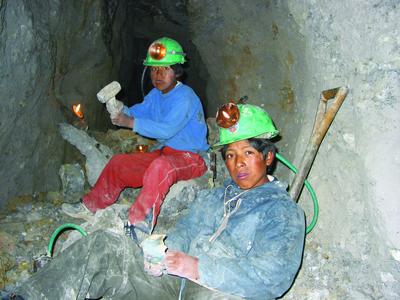
The Devil’s Miner began as a project about devout Catholics who also happen to worship Satan — or if not Satan himself, then something very much like him. Apparently the Bolivian miners who populate this film do believe that God rules above the ground, but they also believe that a capricious, horned, and rather well-endowed entity called “the Tio” rules below.
And so, in addition to attending mass at the local Catholic church, these miners also make offerings of garlands, food, even cigarettes to the idols that lurk in the corners of the tunnels where they work. While there is a hint of irreverence about all this — I find the cigarettes dangling from the Tio’s mouth particularly difficult to take all that seriously, and co-director Kief Davidson said after last Friday’s screening that the miners encouraged the filmmakers to swear at the statues because this, too, is considered an “offering” of sorts — we also see the local people sacrifice a llama and splatter its blood around the door to the mine, in the hope that the Tio will “drink” this blood and not their own. What makes this particularly striking is that a cross — the symbol of the sacrifice that brought an end to all blood sacrifices, as far as Christians are concerned — is carved into the doorway that the locals have splattered.
I was drawn to this film by its religious subject matter, and so were the filmmakers, but there is a fair bit more to this story. After the screening, co-director Kief Davidson said he and Richard Ladkani were initially intrigued by the religious stuff, but once they got to Bolivia, they discovered that a lot of young boys were working in the mines despite the labour laws forbidding such things; and so they decided to make a film focusing on one of these boys.
The particular boy they had in mind was 12 when they began looking for funding, and by the time they got the funding five years later, he was too old and he had already successfully escaped the mines for either school or some other, more appropriate form of work. But the 14-year-old they found to replace him — a boy who sometimes works with his younger brother, and who works to support his even younger sister and their widowed mother — is a remarkably interesting subject in his own right: mature beyond his years, struggling to get an education even as the work that makes school affordable keeps him away from school, etc., etc.
Davidson said the filmmakers decided they couldn’t just abandon these kids once they had finished shooting the film, so they have set up a fund that enables them to go to school and stay out of the mines for good; and their hope is that the film will continue to raise awareness and financial support for children like these, especially once the film comes out on DVD.
I don’t consider myself a particularly claustrophobic person, but there were scenes in this film that made me feel incredibly cramped, as though I were being forced to maneuver in very tight spaces. In one scene, the two boys are sitting in a tunnel, and the elder brother is trying to explain to the younger brother the things he has been learning at school. Then, all of a sudden, an explosion goes off. The conversation stops. Then another explosion goes off. And another. The two boys get up, the older brother counting the explosions as they go, and they make their way through the tunnels to the exit, which could be hundreds of meters away. It’s a somewhat scary moment, made only slightly less suspenseful by the fact that the existence of this footage proves that the filmmakers made it out with them.
There is also a brief interview with the local priest, who says he needs to love these people before he can show them that there exists a God who is stronger than the Tio. I can see his point, but we are also told that Tio worship goes back to the days of the Conquistadors — to the days when the Native Americans thought the arriving Europeans were gods, only to be disappointed by their hellish behaviour — and after so many centuries, I have to wonder at what point someone might say enough is enough.
We are also told that the Conquistadors introduced Tio worship to keep the workers in line. I know next to nothing about the political situation in Bolivia or its relationship to the mining industry, but we are told that the mines are now run by worker-owned collectives, so it seems that the people have taken back some things, and achieved some form of empowerment, at least. It’s a shame that the legacy of fear and death perpetrated by those conquerors continues to leave its scar on these people, though.
There is just one more screening of The Devil’s Miner, Thursday morning at the Granville theatre. See it if you can!
Completely unrelated film festival note: Work prevented me from seeing Arvo Pärt: 24 Preludes for a Fugue last Friday as I had hoped, and since that was the last of three scheduled screenings, I thought for sure I had missed it altogether. But now comes word that it will be back for an encore performance at the Vancity Theatre tomorrow night! It’s rare that a film gets more than two screenings, so if this film is getting four, then it must be popular!











